We used to be religious followers of the 70 Mile Coastal Yard Sale, held each September along the southeastern shore of Prince Edward Island. Among other things the sale allowed us to gain insight into the Christmas gifts of the previous year that didn’t “take”–the bread makers, exercise devices, etc. that had been gathering dust long enough to get put out for sale. Sometimes you’d see the same items available for sale the next year further down the road, as they gradually got repurposed through the community.
I spotted this Mikinduri Children of Hope Yard Sale notice this morning and noticed they include a list of items that are simply unsaleable enough to be useless for their fundraising purposes: baby equipment, tires, old computers, TVs (except flat screens) and encyclopedia sets.

On our walk the other night, passing by 35 Prince Street, I told Oliver about the history of Eddie’s Lunch, Viva’s, Marina Grill and Kozy Korner, which have occupied the corner storefront, in succession, over the last 20 years.
Here’s Eddie’s Lunch in 1999:
And here’s Kozy Korner, now closed and to be replaced, we are told, with yet another restaurant:

Update in November 2017: the store at 35 Prince Street is again being renovated–from the looks of things it’s a “down to the lathe” renovation inside. A new covering on the old sign has gone up. The new place hasn’t opened yet, and the sign’s already peeling, which doesn’t bode well; perhaps it’s only temporary.

Update in December 2017: the temporary, peeling sign that was pasted over the old sign, has been replaced with a purpose-built sign. There’s a lot of activity inside this week, and the convenience store shelves are stocked with M&Ms, so I suspect that the re-opening is imminent.
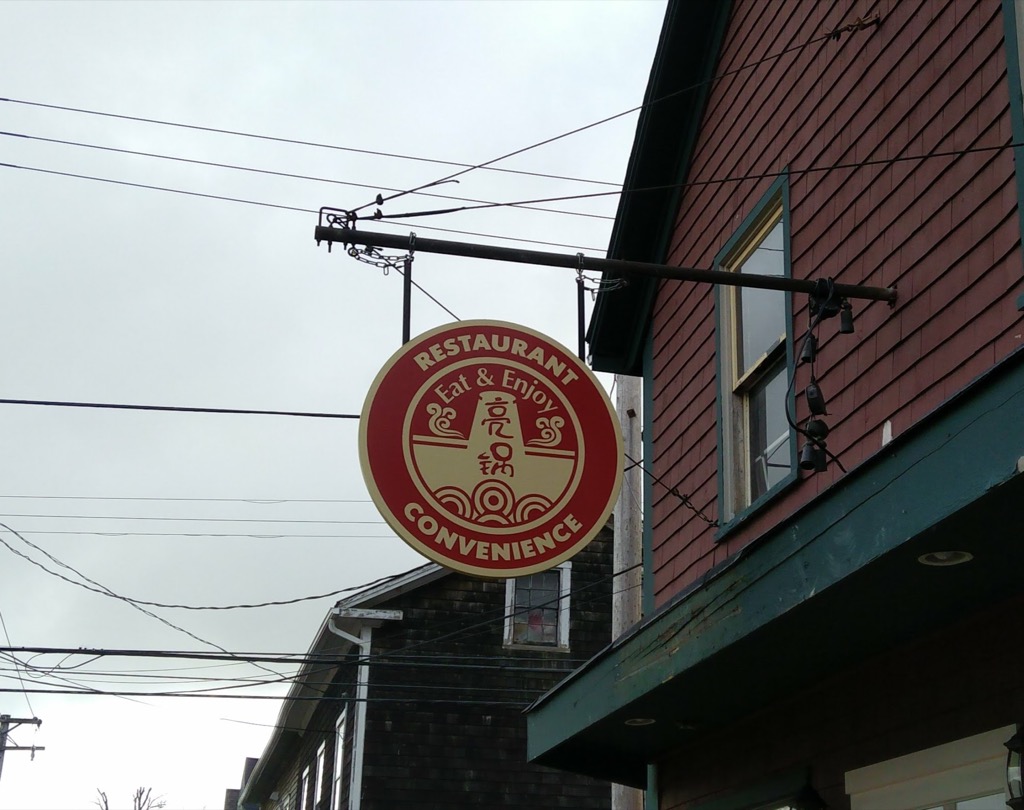
Update in April 2019: The Eat & Enjoy Restaurant opened in January 2018 and lasted about 9 months before it, at its companion convenience store, closed. We ate there once, and had a nice hot pot meal.
On April 25, 2019 a new place, Saigon Bistro, opened in its place:

As of July 27, 2020, Saigon Bistro’s signage was replaced with Sai Gon Cuisine, and a repainted-in-green building. For the first time since the Eddie’s Lunch days the main sign is now mounted flush on the building rather than on the hanging signpost:

Semantic Web Systems resources, by Amy Guy, is a remarkably clear-worded introduction to triples, ontologies, and related topics. If, like me, things like RDF have always existed in the “yah, okay, I sort of understand all that enough to get on” space of your brain, this is a good primer. Especially if you’re trying to grok Solid (in the introduction for which I found the pointer to it).
Triples are almost-human-readable statements, made up of [subject, predicate, object]. When you put lots of triples together and there is overlap in subjects and objects, they form a graph; subjects and objects are nodes (circles), and predicates are arcs (lines).
Sarah put a letter S on the night train from Borden to Charlottetown, and it was hanging outside our front door when we opened it late last night, thanks to the kindness of a Handpie Company customer who’d been headed our way.
This was the key to unlock the secrets of taking Pie Man № 1 and adding struts (wings? arms?) to allow him to slot into Sarah’s menu letterboard.

Using my calipers, I measured the depth of the strut and found it to be 3.45 mm deep; earlier Sarah had told me that the spacing between the slots on her letterboard are spaced at 1/4 inches. So I altered the original model of Pie Man in Tinkercad and added two 3.45 mm struts, spaced 1/4 inches apart:

I loaded this new model into Cura, exported it as a G-code file, and set it printing on the Monoprice Select Mini. To ensure that it adhered to the bed, I told Cura to give it a wide “brim,” which is a single layer surrounding and loosely coupled to the model.
When Pie Man № 2 emerged, it was immediately apparent there was a problem: because the “face” was now printing face down on the bed, it was gnarled and ugly in a most unappealing way. I was able to clean it up somewhat by slicing off the remnants of the brim with a knife, but it still wasn’t Handpie Company-worthy:
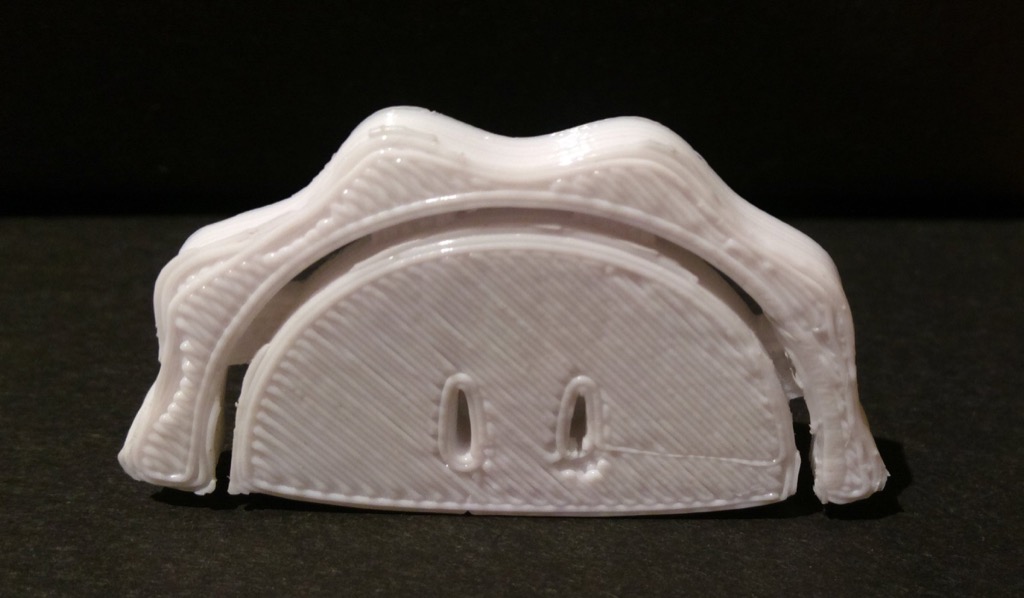
For Pie Man № 3, I decided to try to solve this problem by flipping him over in Tinkercad, so that the face would be face up on printing:
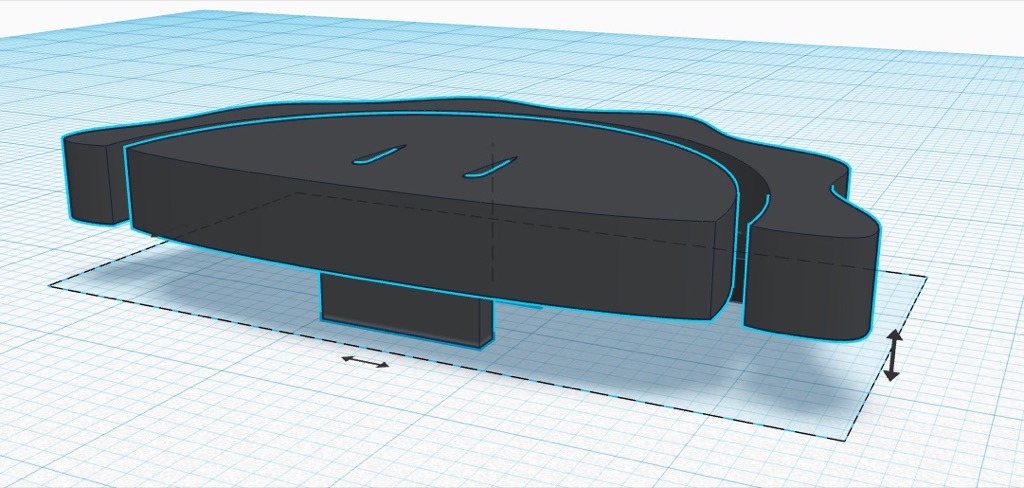
To allow this to print without collapsing in on itself, in Cura I selected the “enable support” option to print support material around the struts that I could later strip away; here’s what Pie Man looked like in Cura just before I output the G-code:
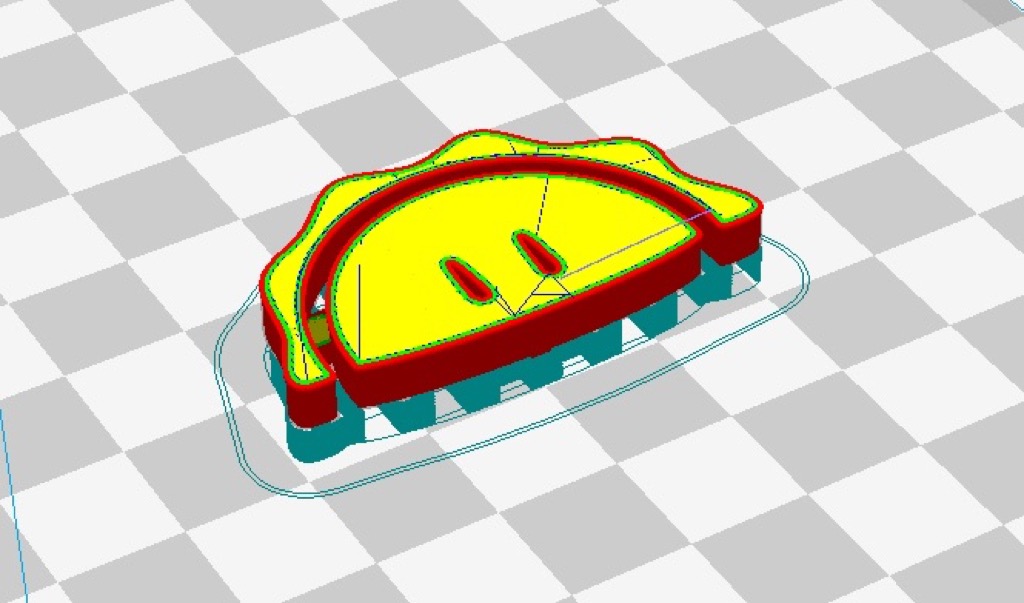
Pie Man № 3 also took 35 minutes to print, and when he emerged from the digital womb, he was a much more impressive sight:

Curiously, I did something wrong when I flipped the model in Tinkercad, so only a single one of the “joiners” that keep Pie Man’s hair attached to his face ended up printing (you can see this on the left side). This turns out to have been a fortuitous mistake, as it turns out to be just strong enough with a single connection, and the result is more visually pleasing.
I’ll get Pie Man № 3 up to Sarah for field testing as soon as possible (Are you headed to Borden this weekend? Do you have space for a small, friendly Pie Man in your car? Please let me know).
If it looks like he’ll work out, I’ll print a whole family. Stay tuned.
The water at Confederation Landing Park was as smooth as glass last night, so photos we took across the marina look remarkably realistic when turned upside down.

With a new season of The Amazing Race now underway, Edward Hasbrouck is back with his episode-by-episode commentary. For episode one he focuses on the difficulty that racers, not allowed to use smartphones, have with seemingly simple navigation tasks:
Travellers today aren’t likely to need to fall back on their ability to handle horses. It’s still common, however, to find yourself in a spot where your smartphone is broken, lost, stolen, or has no signal. It’s still worthwhile, I would argue, to learn and to maintain your ability to function without a smartphone, even if you carry one and use it as your primary tool for many tasks. The more you rely on your smartphone, the more you should have a “Plan B”.
Before you leave home, make a list of all the things for which you use your phone. Think about each of them, and how you would accomplish the same task without your phone, or whether you would be willing and able to do without it.
What are those functions for which you have come to rely on your phone, especially when you are away from home? Or for which, if you are younger, you have never used any tool other than a cellphone? (What’s a “phone booth”? What’s a “cybercafe”?) What’s your “Plan B” for travel without your phone?
I once prided myself on my ability to, using only the lay of the land, find a muffler shop in any city I landed in (this was of necessity: my cars of yore were always in need of muffler work when I traveled cross-country). These days, though, as the urban landscape has changed, and my navigation skills have atrophied in the age of Google Maps, I’m not so sure.
Indeed, when we were in Tokyo in 2013, we were cemented to our smartphone and its Google Maps-powering GPS for almost everything. We didn’t have a plan B (other than “a spare battery”), and had the phone failed us we would have had an interesting time getting back to our hotel via celestial navigation.
It amazes me to think back to my time in Seoul, in the late 1990s, when I lost my travellers cheques and got them replaced with benefit of neither mobile phone nor the ability to speak Korean. As I pointed out when I wrote about that episode earlier, the real question to ask yourself not is now “what do I do without my phone,” but rather “what do I do if I lose my debit card?”
The ability to stick a card into an ATM anywhere from Rochester to Riga and withdraw local cash is something we take for granted, at least when traveling in the north. In many situations losing my debit card would sink me far deeper than not being able to use Google Maps (it’s for this reason that we have the “carry an emergency $50 somewhere” rule when traveling).
A couple of months ago I stumbled across this glowing review of the Monoprice Select Mini 3D printer on YouTube. I previously knew Monoprice as a company that sold good quality cables and computer accessories, shipped to Canada at reasonable prices. I didn’t know they dealt in 3D printers, but my good experiences with them on the USB-cable-front prompted me to take a look.
Alas, they were sold out of printers; on a lark I added my email address to the “alert me when this is off backorder” system, and forgot all about it.
Then, three weeks ago, I got the email: we have printers.
For $199.99 US, what did I have to lose? So I immediately ordered one (they were sold out shortly thereafter).
Last Friday afternoon, it arrived in our community mailbox (its box fits exactly in the size of the larger of the two package bins in the mailbox; someone did their package-sizing right!).
I was consumed with other activities until Saturday afternoon when I loaded the box onto a dolly and rolled it along to the office.
On the way I stopped in for coffee at Receiver, and while sitting in the window drinking my macchiato, I had a chat with the personable Sarah Bennetto O’Brien, proprietor of the recently-opened Handpie Company in Borden.
“What’s in the box?”, she asked.
“Oh, it’s my new 3D printer,” I replied, quietly ashamed at the implicit geekiness.
I need not have worried.
“I’ve been looking for someone to 3D print me something!”, Sarah exclaimed.
What followed was an agreement that I would try to print her a tiny Pie Man for her menu letterboard, said “pie man” being the visual identity of the new enterprise:

The 3D printer wasn’t even out of the box yet, and I had my first customer!
A few days later, Sarah emailed along a high resolution JPEG of Pie Man.
I used the handy Online SVG Image converter tool to convert this JPEG to a vector SVG file:
I then imported this SVG into Tinkercad, Autocad’s web-based 3D design tool:

I immediately realized that I had a problem: Pie Man is actually two objects, not one. That’s fine for the page, but for a 3D object, if I just printed it as-is it would end up as Pie Man Hair and Pie Man Face.
To bring hair and face together, I used Tinkercad to drop some “struts” into four places; thickening up and sizing Pie Man in the process. I made the struts shallow enough so that, I reasoned, they wouldn’t be noticeable on the final object:

With Pie Man now successfully held together, I exported him from Tinkercad as an STL file. I imported the STL file into Cura, the excellent and free program for converting 3D models into the G-code that 3D printers use as their Turtle-graphics-like instructions:
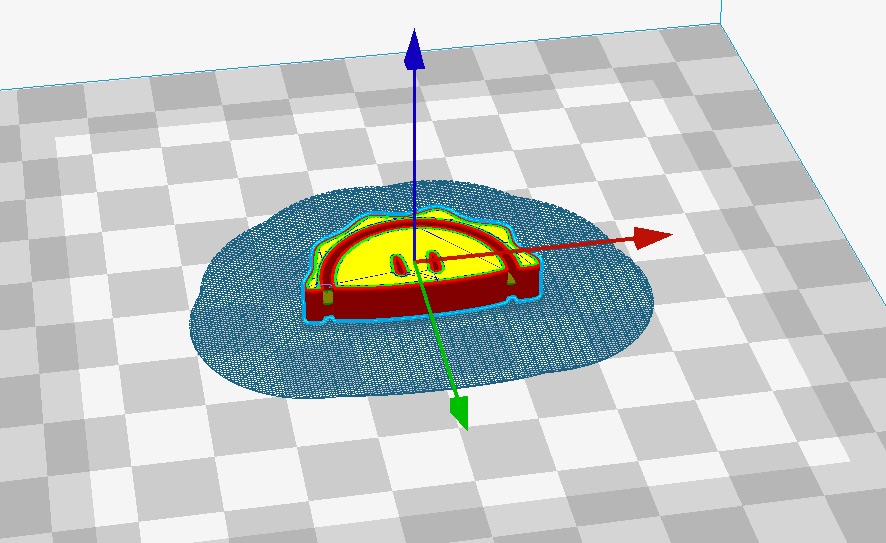
I tried to find the best settings for the G-code file by reading Monoprice’s thin documentation and by gleaning hints from the Monoprice Select Mini Wiki. I saved the result on the SD card that was included with the printer, pre-heated the hot end and the bed, and set it printing:
Exactly 30 minutes later, Pie Man № 1 was fully conjured. I peeled him away from the “raft” I’d had the printer create underneath him and, voila, here’s what I ended up with:

I’m very happy with the result: the struts are, as I thought, not too obvious and they don’t detract from Pie Man’s identity, especially when viewed from a distance. His eyes need a little work: I might widen them a little in the model to avoid the mismatchedness that resulted (or I might be able to ream them out with a knife after printing, which might be easier).
The next step is to fine-tune the model for Pie Man № 2, which will have “letterboard” legs attached. To my surprise, this seems like fresh terrain: I thought I’d be able to find existing 3D models to use as the basis for the size and shape of the legs, but I haven’t been able to. So Sarah is going to put a sample letter from her letterboard on the next train from Borden to town, and I’ll use that to work from.
If all goes well, you should see Pie Man, in all his 3D splendor, on the wall at The Handpie Company, before the month is out.
Rick Steves has caused me to reevaluate my opinion of Rick Steves:
Back home, one of my pet social causes has long been affordable housing. Twenty years ago, I devised a scheme where I could put my retirement savings not into a bank to get interest, but into cheap apartments to house struggling neighbors. I would retain my capital, my equity would grow as the apartment complex appreciated, and I would suffer none of the headaches that I would have if I had rented out the units as a landlord. Rather than collecting rent, my “income” would be the joy of housing otherwise desperate people. I found this a creative, compassionate and more enlightened way to “invest” while retaining my long-term security.
Steves just gave a $4 million apartment complex to the YWCA.
(via Fresh Signals, a feed that, for me, has been exactly that for the past couple of weeks that I’ve been subscribed).
While on The Beginning Day of Easter. How Do People Like Buddhists Celebrate? How Do Scientists Celebrate? How Do Atheists Celebrate?
Yes, how.
My disappearance down the Ruskin rabbit hole continues.
Today I found the very helpful Post Offices and Postmasters tool from Library and Archives Canada, which led me to the record for the Ruskin, PEI post office, and the following information:
- The post office opened on October 1, 1881 and closed on August 15, 1913
- Over that period there were five postmasters: Joseph Haley, Jos. McInnis, Mrs. Mary Ann Hayley, Charles Grant and Michael Collins.
- When the office closed, the reason given was “Closed R.M.D.”
Also from Library and Archives Canada is the Electoral Atlas of the Dominion of Canada, which has an entry for King’s County and an accompanying map:
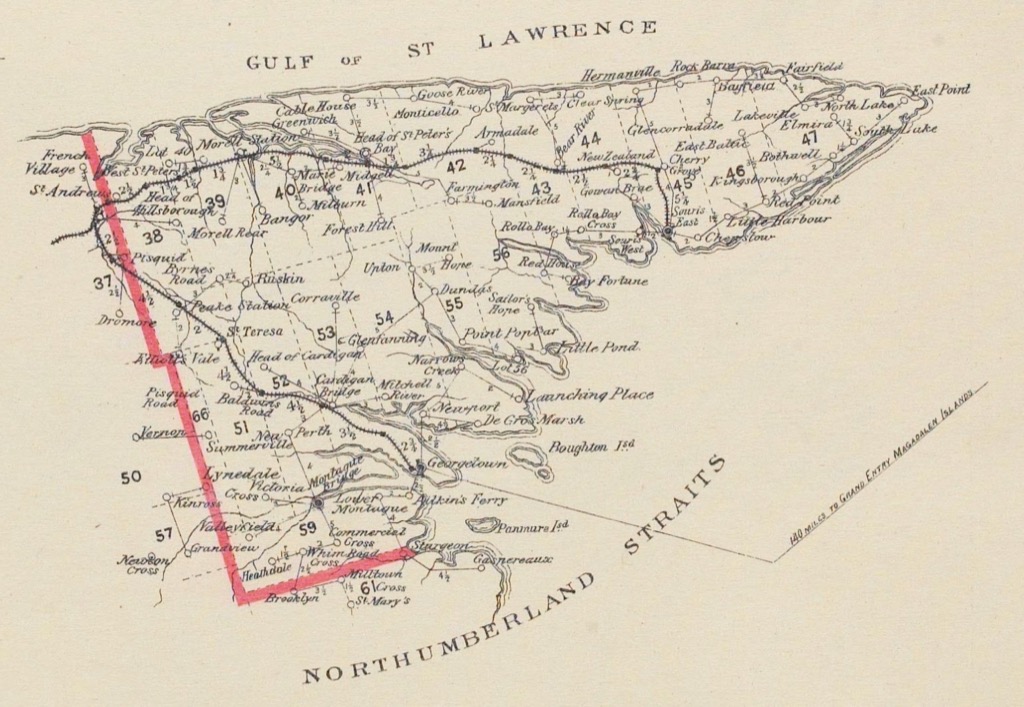
Sure enough, at the top of Lot 52 is the Ruskin Post Office, 2¼ miles east of Byrne’s Road:
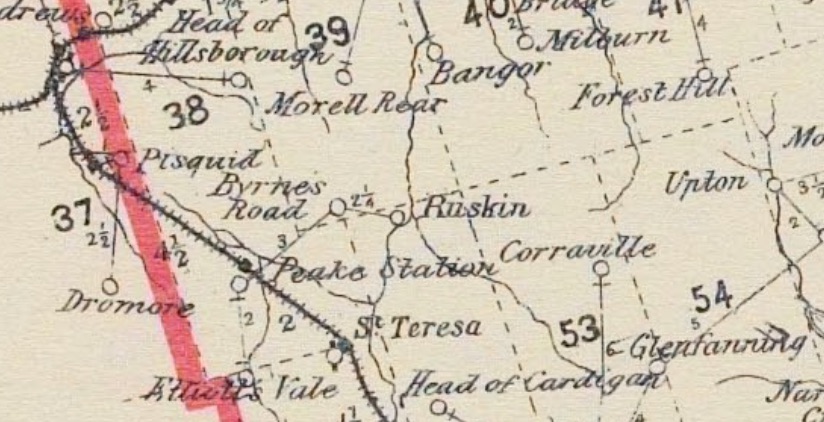
 I am
I am